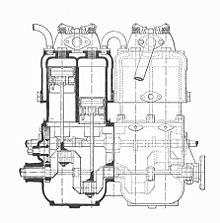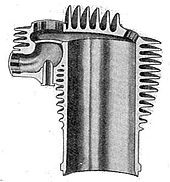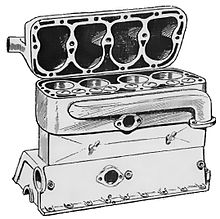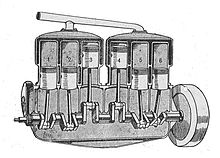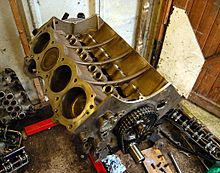- Monobloc engine
-
A monobloc or en bloc engine is an internal-combustion piston engine where some of the major components: cylinder head, cylinder block, or crankcase are formed, usually by casting, as a single integral unit, rather than being assembled later. This has the advantages of improving mechanical stiffness, and also improving the reliability of the sealing between them.
Monobloc techniques date back to the beginnings of the internal combustion engine. Use of the term has changed over time, usually to address the most pressing mechanical problem affecting the engines of its day. There have thus been three distinct uses of the technique:
- Cylinder head and cylinder
- Cylinder block
- Cylinder block and crankcase
In most cases, any use of the term describes a deliberate single-unit construction, opposed to the more common contemporary practice. Where the monobloc technique has later become the norm, the specific term falls from favour. It is now usual and un-noteworthy practice to use monobloc cylinders and crankcases, but a monobloc head (for a water-cooled inline engine at least) would be regarded as peculiar and obsolescent.
Contents
Cylinder head
The head gasket is the most highly stressed static seal in an engine and was a source of considerable trouble in early years. The monobloc cylinder head forms both cylinder and head in one unit, thus avoiding the need for a seal.
Along with head gasket failure, one of the least reliable parts of the early petrol engine was the exhaust valve, which tended to fail by overheating and burning. A monobloc head could provide good water cooling, thus reduced valve wear, as it could extend the water jacket uninterrupted around both head and cylinder. Engines with gaskets required a metal-to-metal contact face here, disrupting water flow.
The drawback to the monobloc head is that access to the inside of the combustion chamber (the upper volume of the cylinder) becomes difficult. Access through the cylinder bore is restricted for machining the valve seats, or simply for inserting angled valves. An even more serious restriction is that for the maintenance task of de-coking and re-grinding the valve seats, a regular task on older engines. Rather than removing the cylinder head from above, the mechanic must now remove pistons, connecting rods and the entire crankshaft from beneath.[3][4]
One solution to this for side-valve engines was to place a screwed plug directly above each valve, and to access the valves through this (illustrated). The tapered threads of the screwed plug provided a reliable seal. For low-powered engines this was a popular solution for some years. It was difficult to cool this plug, as the water jacket didn't extend into the plug. As performance increased, it also became important to have better combustion chamber designs with less "dead space". One solution was to place the spark plug in the centre of this plug, which at least made use of the space. However this also placed the spark plug further away from the main combustion chamber, leading to long flame paths and slower ignition.
During World War I, development of the internal combustion engine progressed enormously. After the war, as civilian car production recommenced, the monobloc cylinder head was required less frequently. Only high-performance cars such as the Leyland Eight of 1920 persisted with it.[5] Bentley and Bugatti[3][6] were other racing marques who notably adhered to them, through the 1920s and into the 1930s.
Aircraft engines at this time were beginning to use high supercharging pressures, increasing the stress on their head gaskets. Engines such as the Rolls-Royce Buzzard used monobloc heads for reliability.[7]
The last engines to make widespread use of monobloc cylinder heads were large air-cooled aircraft radial engines, such as the Wasp Major. These have individual cylinder barrels, so access as a monobloc is less restricted than on inline engine. As they are also of high specific power and require the utmost reliability, the advantages of the monobloc remained attractive.
The difficulties of machining, and maintaining, a monobloc cylinder head were always a severe drawback to it. As head gaskets became able to handle the heat and pressure necessary, the technique went out of use. It is almost unknown today.
Cylinder block
Casting technology at the dawn of the internal combustion engine could reliably cast either large castings, or castings with complex internal cores to allow for water jackets, but not both simultaneously. Most early engines, particularly those with more than four cylinders, had their cylinders cast as pairs or triplets of cylinders, then bolted to a single crankcase.
As casting techniques improved, the entire cylinder block of four, six or even eight cylinders could be cast as one. This was a simpler construction, thus cheaper to make, and the communal water jacket permitted closer spacing between cylinders. This also improved the mechanical stiffness of the engine, against bending and the increasingly important torsional twist, as cylinder numbers and engine lengths increased.[8] In the context of aircraft engines, the non-monobloc precursor to monobloc cylinders was a construction where the cylinders (or at least their liners) were cast as individuals, and the outer water jacket was applied later from copper or steel sheet.[9] This complex construction was expensive, but lightweight, and so it was only widely used for aircraft.
V engines remained with a separate block casting for each bank. The complex ducting required for inlet manifolds between the banks were too complicated to cast otherwise. For economy, a few engines, such as the V12 Pierce-Arrow, were designed to use identical castings for each bank, left and right.[10] Some rare engines, such as the Lancia 22½° narrow-angle V12 of 1919, did use a single block casting for both banks.[11]
Modern cylinders, except for air-cooled engines and some V engines, are now universally cast as a single cylinder block.
Crankcase
As casting improved and cylinder blocks became a monobloc, it also became possible to cast both cylinders and crankcase as one unit. The main reason for this was to improve stiffness of the engine construction, reducing vibration and permitting higher speeds.
Most engines, except some V engines, are now a monobloc of crankcase and cylinder block.
Modern engines - Combined block, head and crankcase
Light-duty consumer-grade Honda GC-family small engines use a monobloc design where the cylinder head, block, and half the crankcase share the same casting, termed 'uniblock' by Honda.[12] One reason for this, apart from cost, is to produce an overall lower engine height. Being an air-cooled OHC design, this is possible thanks to current aluminum casting techniques and lack of complex hollow spaces for liquid cooling. The valves are vertical, so as to permit assembly in this confined space. On the other hand, performing basic repairs becomes so time-consuming that the engine can be considered disposable. Commercial-duty Honda GX-family engines (and their many popular knock-offs) have a more conventional design of a single crankcase and cylinder casting, with a separate cylinder head.
Honda produces many other head-block-crankcase monoblocs under a variety of different names, such as the GXV-series. They may all be externally identified by a gasket which would bisect the crankshaft on an approximately 45° angle.
Exhaust valve failure is common and, owing to the monobloc design, so labour-intensive to repair that the engine is normally discarded.
References
- ^ Kennedy, Rankin (1912 edition of 1905 book.). The De Dion-Bouton Engine and Cars. The Book of Modern Engines and Power Generators. London: Caxton. pp. 78–89.
- ^ Rankin Kennedy, Modern Engines, Vol III, pp. 163-167
- ^ a b Conway, H.G. (1984). "Type 41 Royale". Bugatti. Great Marques. Octopus. pp. 64. ISBN 07064-2046-2.
- ^ Stein, Ralph (1973). The World of the Automobile. Hamlyn. pp. 172–173. ISBN 0-600-39305-4.
- ^ Posthumus, Cyril (1973). Vintage Cars. Hamlyn. pp. 59. ISBN 0-600-39131-0.
- ^ Stein, Ralph (1979). The Greatest Cars. Ridge Press. pp. 75. ISBN 600-32186-X.
- ^ Ludvigsen, Karl (2005). The V12 Engine. Haynes Publishing. pp. 99. ISBN 1-84425-004-0.
- ^ R. A. Beaumont, AMIMechE, AFRAeS (c.1948). "11.Aero-engine design and Construction". Internal Combustion Engines Illustrated. London: Odhams. p. 227.
- ^ IC Engines Illus, Aero-engines, p. 231
- ^ Ludvigsen, V12 Engine, p. 120
- ^ Ludvigsen, V12 Engine, p. 50-53
- ^ "Honda General Purpose Engines: GC Series - Single Cylinder". http://www.perr.com/honda.html. Includes sectioned drawings
Categories:- Engine technology
- Piston engine configurations
Wikimedia Foundation. 2010.


